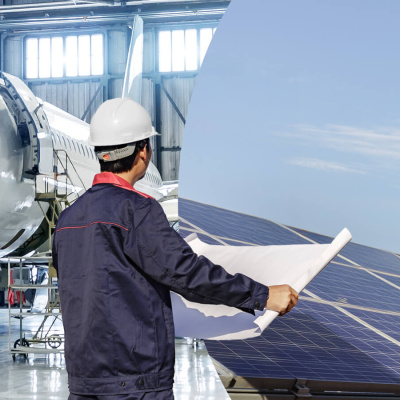We are the Centre of Competence for Climate, Environment and Noise Protection in Aviation at Hessen Trade & Invest GmbH. CENA Hessen is an initiator for a sustainable future of aviation. Our goal is to establish Hessen as a pioneer for sustainability in the aviation industry - with the Frankfurt Airport hub playing a key role in this.

About CENA Hessen
We were founded on 1 January 2020
We are located in Frankfurt, in the House of Logistics and Mobility (HOLM)
We are part of Hessen Trade & Invest GmbH
We work on behalf of the Hessian Ministry of Economic Affairs, Energy, Transportation, Housing and Rural Areas (HMWVW)
We are researching the future of aviation
Together with partners from research, business and politics, we develop innovative projects for sustainable aviation. We function as coordinator and conduct our own research.
Our research focuses on the Decarbonization and Defossilization of aviation, in particular through Sustainable Aviation Fuels (SAF), but also through alternative propulsion systems such as hydrogen or electric aircraft. We conduct research into the production and supply chain, the required infrastructure, market design, financing and suitable framework conditions.
We also develop strategies for sustainable airport operations, from emissions monitoring and resource management to airport-related mobility.
On behalf of the aircraft noise protection officers of the state of Hessen, we also investigate the causes of noise pollution and possibilities for technical noise reduction on aircraft.

Our projects
We initiate, coordinate and manage projects and initiatives in the field of climate protection in aviation. Our focus is on the topics of “climate protection”, “sustainable aviation fuels” and “framework conditions”.
We consult, network and share knowledge
- Events and networking: We regularly organize expert workshops and symposia on current topics relating to climate protection in aviation and promote the exchange of knowledge between experts.
- Lectures and panels: We share our knowledge in lectures and panel discussions. On request, we give lectures at universities and supervise Bachelor’s and Master’s theses.
- Publications and public relations: Our publications offer in-depth insights into our diverse research topics. Through our public relations work, we bring our expertise closer to a broad audience, e.g. through CENA InfoHub.
- Consulting and partnerships: We advise the Hessian Ministry of Economics, Energy, Transport, Housing and Rural Areas with statements on proposed legislation. We are also involved in the German government’s Working Group on Climate-Neutral Aviation (AKKL) and the EU working group Alliance for Zero Emission Aviation (AZEA).
We are part of Hessen Trade & Invest GmbH
The Center of Competence for Climate, Environment and Noise Protection in Aviation – CENA Hessen – is supported by Hessen Trade & Invest GmbH (HTAI). HTAI is the economic development agency of the State of Hessen. Its central task is to secure and increase the competitiveness of Hessen as a business and technology location. HTAI offers a unique strategic combination of location marketing, foreign trade, investor support, technology and innovation promotion and advice on EU funding programs. It is the central point of contact for companies as well as for scientific, political and social institutions.
